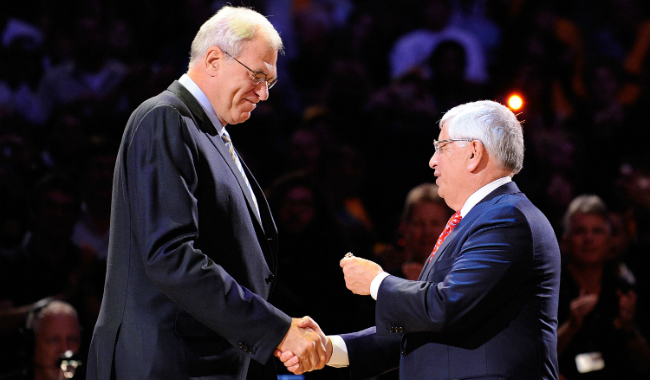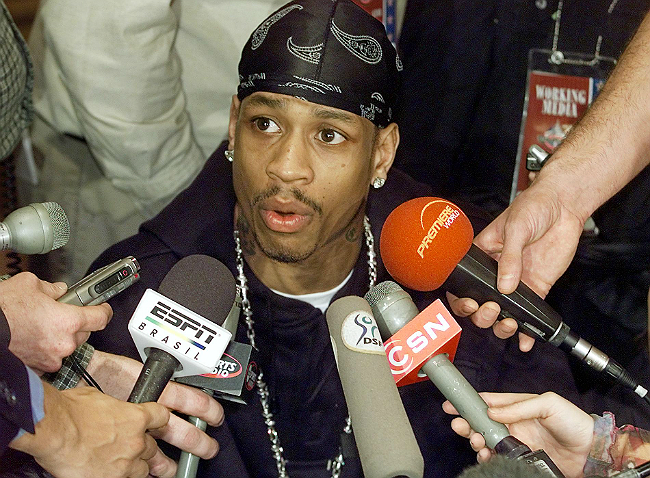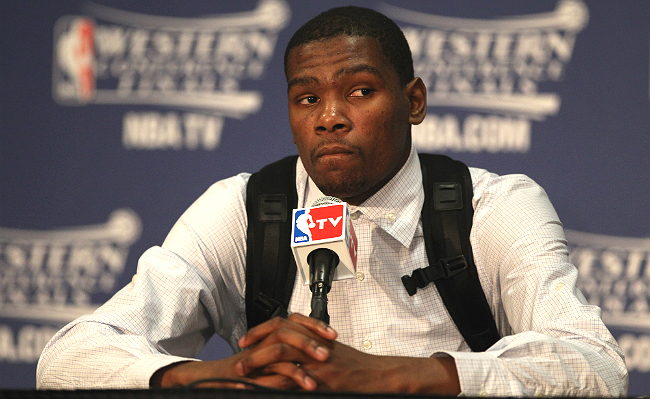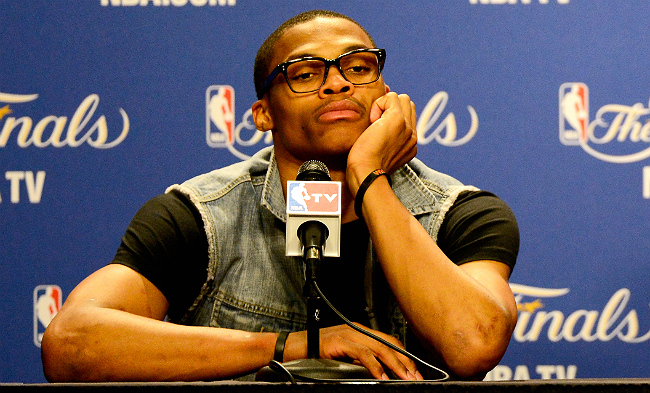
The mid-2000s saw the NBA reeling in the aftermath of the Malice at the Palace. Feeling alienated by the rise of expressions of hip-hop culture among NBA players, corporate sponsors were threatening to leave the league in droves. In order to bridge the growing gap between the league and its financial base, David Stern and the NBA’s white leadership commenced an all-out assault on the symbols of blackness sported by the hip-hop generation, with a dress code as its chief weapon.
And as such, 12 years ago in October, Stern and the NBA implemented a dress code, one that remains in effect to this day.
The new rules did not simply call for players to dress in “business casual.” The rules specifically outlawed certain clothing items strongly identified with hip-hop: sleeveless shirts, shorts, jerseys, T-shirts, sports apparel, chains, pendants, medallions, sunglasses and headphones were included among the banned items. “Headgear of any kind” was targeted in particular, unless said headgear was pre-approved by the team and included some sort of team identifier.
NBA executives tried to pass it off as not a racist measure but one to foster professionalism. David Stern said, “The notion is that if you’re a professional, with it are certain protocols. One of them is the way you dress when you’re on business.”

As Phil Jackson put it, “Our audience is corporate businessmen and corporate businesswomen and kids. So it’s a different audience that you’re dealing with and these players should be aware of it.”
But no matter how men like Jackson or Stern justified the policy, it was a clear attack on the culture of the young black men who comprised the association’s roster. Many players instantly called out the code’s inherent racism. “When I saw the part about chains, hip-hop and throwback jerseys,” Celtics star Paul Pierce said, “I think that’s part of our culture.”
“The NBA is young black males.” Jermaine O’Neal sarcastically asked, “What’s next, we can’t wear our hair in cornrows?”
But the most striking commentary came from Allen Iverson, whose famous “We talkin’ about practice?” press conference, conducted in a white flat-brim Boston Red Sox cap and an oversized white t-shirt, was almost certainly high in the minds of Stern and his front office fellows when the code was implemented.
“You can put a murderer in a suit,” Iverson said, “and he’s still a murderer.”

NBA owners and executives have always walked a tightrope in selling a mostly black league to white America. But the events of the mid-2000s created a perfect storm that threatened the association.
“Among the many factors, there were two that help us understand ‘why then?’,” Dr. David J. Leonard, professor of critical culture, gender and race studies at Washington State University and author of After Artest: The NBA and the Assault on Blackness told UPROXX. “First, the retirement of Michael Jordan created a racial vacuum in the league. The NBA, and its media partners had successfully created a narrative and image around Jordan as both the face of the league and the embodiment of post-raciality. His retirement left the league without a player who was embodying these colorblind narratives. Second, the rise of hip-hop. The NBA wanted to take advantage of the cultural and economic popularity of hip-hop. Over several years, they sought to manage and control this relationship, so that they could simultaneously profit off hip hop while not alienating white fans.”
Responses around the league varied. Iverson, among the top targets of the rule, bought only the loosest fitting suits he could find, stating his comfort was paramount. Others, like Dwyane Wade, went all out — he got a stylist and found himself on the cover of GQ in October 2006. The most fascinating response was the rise of what many have called “nerd chic,” most famously sported by Russell Westbrook but seen from other black superstars like Wade, Amar’e Stoudamire, Kevin Durant, Dwight Howard and LeBron James. Characterized by large black-rimmed glasses, gingham and argyle patterns, bowties, and of course Durant’s inseparable, safety-strapped backpack from the 2011 playoffs.

“The rise of ‘nerd’ chic, and the player’s responses are clearly a challenge and a subversion to the dress code,” Dr. Leonard says. “It was a sartorial stance that not only made player agency clear but questioned the accepted definitions of what professional clothing looks like.”
Wesley Morris offered a similar assessment in Grantland in 2011: “The cardigans and black frames, the backpacks and everything else: It’s all as overdetermined as what happens on Project Runway with Lady Gaga and Nicki Minaj, and with the drag queens. ‘Nerd’ is a kind of drag in which ballers are liberated to pretend to be someone else.”
Westbrook in particular has worn outfits that fly in the face of traditional masculine norms, outfits that were loud and ridiculous and unlike anything seen in the typical American sports arena. These are not the simple outlandish patterns of a Craig Sager or a Walt Frazier. Just in last year’s playoffs alone, Westbrook wore leather pants and leopard print shoes; designer overalls; and a denim patchwork three-quarter sleeve shirt with fringe leather sneakers. He makes bold fashion decisions that very well might have gotten him laughed out of a locker room in previous decades and has established himself as maybe the most expressive NBA player in the process.

The new fashion statements from NBA players in the era of the dress code were unique and fascinating. But critically for NBA executives, they weren’t threatening.
“Hip-hop’s place within corporate America, it signified streets, ‘ghetto,’ and pathology,” Leonard says. “Westbrook, and others, through their connections with the fashion world, have been able to connect their sartorial choices with industry, with fashion, and with a world of art. Westbrook has been able to paint his sartorial choices as an artistic intervention, a sign of creativity, whereas Iverson and others were seen as expressing ‘thuggery’ and ‘danger.'”
The NBA’s dress code succeeded in removing these threatening symbols from the public eye. With the NBA in a much better financial situation than it was a decade ago, it has proven easy for some to look back and credit the code for a role in the league’s current success.
“It’s funny how you mature and look back at things you’ve done or said and grow from them,” Jason Richardson, an outspoken opponent of the dress code at its inception, told Yahoo last year. “At the time, being young, I thought it was a personal attack to most of the guys in the NBA.” He added, “I didn’t see the bigger picture of making us more approachable to fans and maybe business opportunities off the court.”
Does the NBA’s recent success justify the league’s use of a restrictive and targeted dress code?
“I don’t think so,” Leonard says. “It speaks to how players responded to the draconian and racist policies in not only creative ways but in economic ways. Yes, in the face of discrimination, the players figured out ways to both resist and profit from the rules. This is the story of African-Americans in this country; this is the story of the Blues, Jazz, and hip-hop. This doesn’t make it any less discriminatory and problematic.”
That creativity continued on Opening Night, when Russell Westbrook showed up in one of his most outlandish outfits yet, sporting a kilt, a yellow hoodie and a jean jacket. NBA executives may have managed to push hip-hop imagery away from the cameras, but they can’t squelch the self-expression of the players.
Whatever patronizing and paternalistic rules the league’s powers that be can cook up to mollify their corporate benefactors, the young black men who made up the majority of the NBA have shown they will be able to rise above and continue to express themselves.






